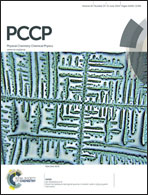A study on the photophysics of 9-amino-10-cyanoanthracene: probing its dual absorption and emission behavior†
Abstract
The photophysics of a donor–acceptor substituted chromophore, 9-amino-10-cyanoanthracene (ACAN), has been investigated in polar and nonpolar solvents to understand its intriguing dual absorption and emission behavior. Steady-state and time-resolved fluorescence studies clearly indicate that the short wavelength emission band of ACAN arises from the higher excited singlet state, S2, while the longer wavelength emission band arises from the intramolecular charge transfer (ICT) state, S1. Interestingly, both these states can be populated by direct excitation from the ground state. Temperature dependent studies reveal a pronounced activation controlled nonradiative decay channel for the ICT state of ACAN. It is proposed that this activation controlled nonradiative de-excitation arises because of a large relative displacement and a cross-over of the potential energy (PE) surfaces of ACAN in the ground and the ICT states, as a result of different twist angles of the amino group in these two states. Qualitative PE diagrams have accordingly been presented to correlate and rationalize the observed results. The present study also brings to light the interesting excited state prototropic behavior of ACAN and the consequent modulation of the ICT emission that has not been reported in the literature so far.


 Please wait while we load your content...
Please wait while we load your content...